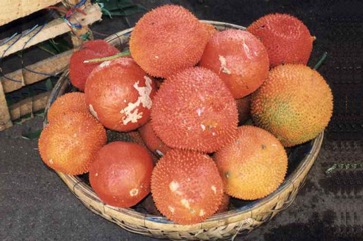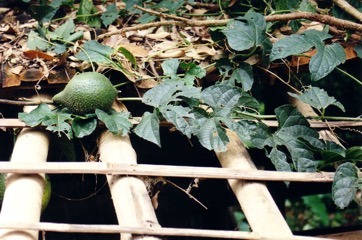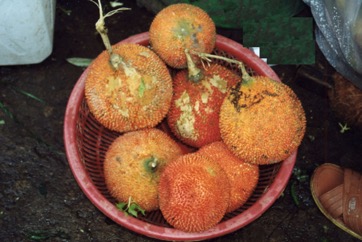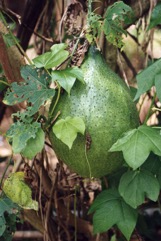Spiny bitter cucumber, Chinese bitter-cucumber

A tropical plant. It suits tropical places but also grows in warm humid climates. It occurs from northern Luzon to southern Mindanao in the Philippines. In XTBG Yunnan. In Sichuan.
Also known as:
Adavi kakara, Aganxi, Baro kakrol, Bhat karela, Bhat kerela, Bolongni kangro, Bonkakrol, Bon-karela, Buyok-buyok, Chinese-cucumber, Cochinchin gourd, Cundeamor, Fak kao, Fak-khao, Gac, Gangerua, Go-ka-kara, Gol kakoda, Golkakra, Gulkakra, Hangathai, Kakrol, Kpak-se-saw, Huihuaigaibu, Jangli-kakrol, Jankha, Kakana, Kakrol, Kankura, Kantola, Karapata, Karkataka, Karol, Khaawz, Khika-khrua, Libas, Makkao, Mubieguo, Nraupui-chi, Parog-parog, Paruk-paruk, Phak-khao, Pupia, Samon-nwe, Sla pouthuowa, Spike-fruited crow's cucumber, Spiny bitter-gourd, Sugod-sugod, Sweet gourd, Tabog-ok, Taboguak, Tangkhapi, Tangkhawt, Taw-thabut, Teruah, Tha-myet, Torobuk, Toropu
Synonyms
- Momordica macropylla Gage
- Momordica meloniflora Hand.Mazz.
- Momordica mixta Roxb.
- Muricia cochinchinensis Lour.
- Zucca commersoniana Ser.
Edible Portion
- Leaves, Vegetable, Fruit, Spice
Where does Spiny bitter cucumber grow?
Found in: Andamans, Asia, Australia, Bangladesh, Cambodia, China, Cuba, Himalayas, India, Indochina, Indonesia, Laos, Malaysia, Myanmar, Northeastern India, Pacific, Papua New Guinea, PNG, Philippines, SE Asia, Sikkim, Taiwan, Thailand, Vietnam
Notes: There are about 50 Momordica species.
Status: Fruit are sold in markets. Leaves are sold in local markets.
Growing Spiny bitter cucumber, Chinese bitter-cucumber
Cultivation: Plants can be grown from seed or cuttings of firm young growth. The tuberous roots can be used. The plants are spaced 130 cm apart.
Edible Uses: The young leafy shoots are eaten cooked. They are often blanched then served with chili sauce or added to soups. The young fruit are cooked and eaten as a vegetable with other vegetables. They are boiled, stir-fried or used in curries.
Production: One plant can produce 4 kg of fruit. There can be 20-25 fruit. In Sikkim fruit are available June to July.
Nutrition Info
per 100g edible portion| Edible Part | Energy (kcal) | Protein (g) | Iron (mg) | Vitamin A (ug) | Vitamin c (mg) | Zinc (mg) | % Water |
|---|---|---|---|---|---|---|---|
| Fruit | 29 | 0.6 | - | - | - | - | 90 |
Spiny bitter cucumber, Chinese bitter-cucumber Photos




References
Ambasta, S.P. (Ed.), 2000, The Useful Plants of India. CSIR India. p 378
Ara, R. I. T., 2015, Leafy Vegetables in Bangladesh. Photon eBooks. p 153
Arora, R. K., 2014, Diversity in Underutilized Plant Species - An Asia-Pacific Perspective. Bioversity International. p 48
AVRDC files
Bandyopadhyay, S. et al, 2009, Wild edible plants of Koch Bihar district, West Bengal. Natural Products Radiance 8(1) 64-72
Bandyopadhyay, S., et al, 2012, A Census of Wild Edible Plants from Howrah District, West Bengal, India. Proceedings of UGC sponsored National Seminar 2012
Borrell, O.W., 1989, An Annotated Checklist of the Flora of Kairiru Island, New Guinea. Marcellin College, Victoria Australia. p 66, 183
Brown, W.H., 1920, Wild Food Plants of the Philippines. Bureau of Forestry Bulletin No. 21 Manila. p 154
Burkill, I.H., 1966, A Dictionary of the Economic Products of the Malay Peninsula. Ministry of Agriculture and Cooperatives, Kuala Lumpur, Malaysia. Vol 2 (I-Z) p 1511
Chowdery, T., et al, 2014, Wild edible plants of Uttar Dinajpur District, West Bengal. Life Science Leaflets. 47:pp 20-36 http://lifesciencesleaflets.ning.com
Cooper, W. and Cooper, W., 2004, Fruits of the Australian Tropical Rainforest. Nokomis Editions, Victoria, Australia. p 142
Deb, D., et al, 2013, Wild Edible Plants and Their Utilization in Traditional Recipes of Tripura, Northeast India. Advances in Biological Research 7(5):203-211
Dhyani, S.K., & Sharma, R.V., 1987, Exploration of Socio-economic plant resources of Vyasi Valley in Tehri Garwhal. J. Econ. Tax. Bot. Vol. 9 No. 2 pp 299-310
Dobriyal, M. J. R. & Dobriyal, R., 2014, Non Wood Forest Produce an Option for Ethnic Food and Nutritional Security in India. Int. J. of Usuf. Mngt. 15(1):17-37
Eiadthong, W., et al, 2010, Management of the Emerald Triangle Protected Forests Complex. Botanical Consultant Technical Report. p 23
Elliot, W.R., & Jones, D.L., 1993, Encyclopedia of Australian Plants suitable for cultivation. Vol 6. Lothian. p 441
Facciola, S., 1998, Cornucopia 2: a Source Book of Edible Plants. Kampong Publications, p 88
Flora of Australia, Volume 8, Lecythidales to Batales, Australian Government Publishing Service, Canberra (1982) p 167
Gangte, H. E., et al, 2013, Wild Edible Plants used by the Zou Tribe in Manipur, India. International Journal of Scientific and Research Publications, Volume 3, Issue 5
Ghosh, A, 2014, Survey of Ethno-medicinal Climbing plants in Andaman and Nicobar Islands, India. Int. J. of Pharm. Life Sci. 5(7): July, 2014:3671-3677
Guite, C., 2016, A study of wild edible plants associated with the Paite tribe of Manipur, India, International Journal of Current Research. Vol. 8, Issue, 11, pp. 40927-40932
Hani Medicine of Xishuangbanna, 1999, p 115
Hill, M. & Hallam, D., (eds), 1997, Na Hang Nature Reserve, Tat Ke Sector. Site description and conservation evaluation. Hanoi. p 77
Hossain, U. & Rahman, A., 2018, Study and quantitative analysis of wild vegetable floral diversity available in Barisal district, Bangladesh. Asian J. Med. Biol. Res. 2018, 4 (4), 362-371
Jacquat, C., 1990, Plants from the Markets of Thailand. D.K. Book House p 56
Japanese International Research Centre for Agricultural Science www.jircas.affrc.go.jp/project/value_addition/Vegetables
Kachenchart, B., et al, 2008, Phenology of Edible Plants at Sakaerat Forest. In Proceedings of the FORTROP II: Tropical Forestry Change in a Changing World. Bangkok, Thailand.
Khumgratok, S., Edible Plants in Cultural Forests of Northeastern Thailand. Mahasarakham University Thailand.
Kuo, W. H. J., (Ed.) Taiwan's Ethnobotanical Database (1900-2000), http://tk.agron.ntu.edu.tw/ethnobot/DB1.htm
Luo, B., et al, 2019, Wild edible plants collected by Hani from terraced rice paddy agroecosystem in Honghe Prefecture, Yunnan, China. Journal of Ethnobiology and Ethnomedicine 15:56
Maghirang, R. G., et al, 2018. Ethnobotanical Studies of Some Plants Commonly Used as Vegetables in Selected Provinces of the Philippines. Journal of Nature Studies. 17(2), 30-43.
Martin, F.W. & Ruberte, R.M., 1979, Edible Leaves of the Tropics. Antillian College Press, Mayaguez, Puerto Rico. p 190
McMakin, P.D., 2000, Flowering Plants of Thailand. A Field Guide. White Lotus. p 47
Medhi, P. & Borthakur, S. K., 2012, Phytoresources from North Cachur Hills of Assam -3: Edible plants sold at Hflong market. Indian Journal or Natural Products and Resources. 3(1) pp 84-109
Medhi, P., Sarma, A and Borthakur, S. K., 2014, Wild edible plants from the Dima Hasao district of Assam, India. Pleione 8(1): 133-148
Menisa, A. A., et al, 2012, Survey and characterization of Indigenous Food Plants in Ilocos Norte, Philippines. SEARCA Discussion Paper series No. 2011-2
Miguel, E., et al, 1989, A checklist of the cultivated plants of Cuba. Kulturpflanze 37. 1989, 211-357
Monsalud, M.R., Tongacan, A.L., Lopez, F.R., & Lagrimas, M.Q., 1966, Edible Wild Plants in Philippine Forests. Philippine Journal of Science. p 456
Murtem, G. & Chaudhrey, P., 2016, An ethnobotanical note on wild edible plants of Upper Eastern Himalaya, India. Brazilian Journal of Biological Sciences, 2016, v. 3, no. 5, p. 63-81
Partha, P., 2014, Ethnobotany of the Laleng (Patra) Community in Bangladesh. Journal of Pharmacognosy and Phytochemistry. 2(6):173-184
Pegu, R., et al, 2013, Ethnobotanical study of Wild Edible Plants in Poba Reserved Forest, Assam, India. Research Journal of Agriculture and Forestry Sciences 1(3):1-10
Pham-Hoang Ho, 1999, An Illustrated Flora of Vietnam. Nha Xuat Ban Tre. p 568
PROSEA handbook Volume 13 Spices. p 277
Rashid, H. E., 1977, Geography of Bangladesh. Westview. p 264
Sharma, B.B., 2005, Growing fruits and vegetables. Publications Division. Ministry of Information and broadcasting. India. p 188
Siemonsma, J. S. and Piluek, K. (Eds), 1994, Plant Resources of South-East Asia No. 8 Vegetables. Prosea Foundation, Bogor, Indonesia, p 206
Singh, H.B., Arora R.K.,1978, Wild edible Plants of India. Indian Council of Agricultural Research, New Delhi. p 77
Singh, P.K., Singh, N.I., and Singh, L.J., 1988, Ethnobotanical Studies on Wild Edible Plants in the Markets of Manipur - 2. J. Econ. Tax. Bot. Vol. 12 No. 1 pp 113-119
Slik, F., www.asianplant.net
Solomon, C., 2001, Encyclopedia of Asian Food. New Holland. p 41
Sundriyal, M., et al, 2004, Dietary Use of Wild Plant Resources in the Sikkim Himalaya, India. Economic Botany 58(4) pp 626-638
Syst. veg. 3:14. 1826
Terra, G.J.A., 1973, Tropical Vegetables. Communication 54e Royal Tropical Institute, Amsterdam, p 59
Tindall, H.D., 1983, Vegetables in the tropics. Macmillan p. 181
USDA, ARS, National Genetic Resources Program. Germplasm Resources Information Network - (GRIN). [Online Database] National Germplasm Resources Laboratory, Beltsville, Maryland. Available: www.ars-grin.gov/cgi-bin/npgs/html/econ.pl (10 April 2000)
Van Sam, H. et al, 2008, Uses and Conservation of Plant Species in a National Park. A case study of Ben En, Vietnam. Economic Botany 62:574-593
World Checklist of Useful Plant Species 2020. Royal Botanic Gardens, Kew
Xu, You-Kai, et al, 2004, Wild Vegetable Resources and Market Survey in Xishuangbanna, Southwest China. Economic Botany. 58(4): 647-667. (As Momordica macrophylla)
Yang, Si-Lin and Walters, T. W., 1992, Ethnobotany and the Economic role of the Cucurbitaceae of China. Economic Botany, Vol. 46, No. 4, pp. 349-367